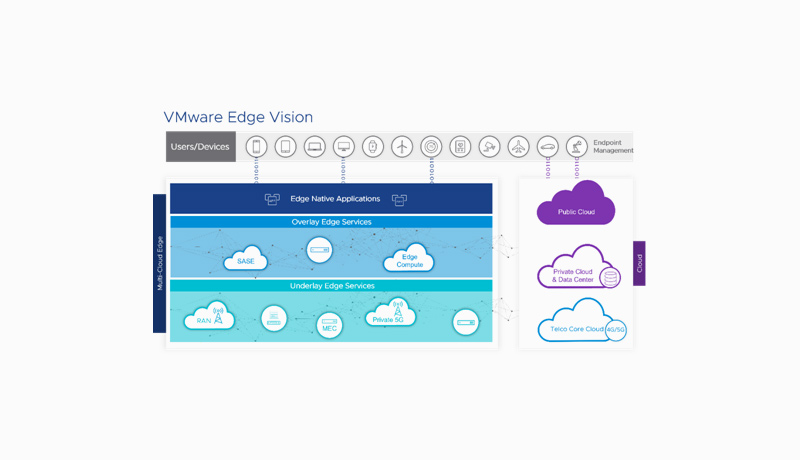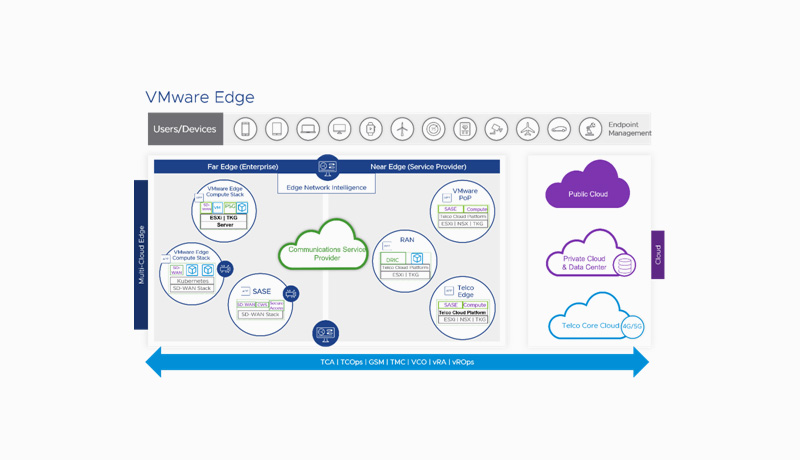12 March 2025, Wed |
2:10 PM

VMware has mapped out a strategy for customers to seize opportunity at the edge. Organizations are dispersing workloads over various clouds while also expanding out to the edge, bringing apps and services closer to where people, data, and objects connect to the networked digital world. At VMworld 2021, VMware detailed how it is assisting customers in making sense of a more complicated, multi-cloud environment, as well as its strategy for assisting customers in navigating the move to the edge. It also announced VMware Edge, a product portfolio that would enable companies to operate, manage, and better protect edge-native apps across various clouds and from any location.
“A new type of workload is emerging – edge-native apps – that must run at the edge to perform as intended. AR/VR, connected vehicles, and immersive gaming are becoming mainstream. 5G has made the use of collaborative robots, drone fleets and digital twins a reality,” said Sanjay Uppal, senior vice president and general manager, Service Provider and Edge, VMware.
He also said, “VMware delivers a trusted foundation – a multi-cloud edge – to help organizations move forward in the new edge reality.”
The edge, according to VMware, is a distributed digital infrastructure for running workloads across several locations, close to the consumers and devices that produce and consume data. The location of a task at the edge is critical to addressing the needs of edge-native apps.

• The near edge is an edge-native workload supplied as a service anywhere between the cloud and the distant customer site.
• The far edge is an edge-native workload that is deployed at a remote client location that is closest to the endpoints.
A multi-cloud edge is required for edge-native apps. One that connects service provider network underlay services (e.g., private connectivity, carrier 5G, network slicing) with overlay services supplied on top (e.g., SASE) and a compute services abstraction for edge applications. All of this is orchestrated by a management layer that ensures observability, installation, configuration, operations, and management are consistent across all edge locations.
VMware Edge brings together VMware products to enable enterprises to deploy, manage, and protect edge-native apps across various clouds at both close and far edge locations. Edge-native apps have specific performance and latency requirements, therefore VMware Edge solutions were created with them in mind.
VMware Edge solutions include:
“Many transformational technologies – 5G, SASE and open RAN, among others – are converging at the edge. Now is the time for organizations to establish a digital foundation for their edge infrastructure. With its leadership in multi-cloud and modern apps, VMware is uniquely positioned to deliver a comprehensive set of solutions that help its customers drive business continuity, agility and create competitive differentiation at the edge,” said Dave McCarthy, IDC Research Vice President, Cloud and Edge Infrastructure Services.

To deliver smooth integrated solutions to customers, VMware has critical collaborations across the broad edge ecosystem. Public cloud providers, service providers, edge-native app developers, network services providers, system integrators, network equipment providers, near-edge hardware manufacturers, and far-edge hardware manufacturers are all part of its extensive partner ecosystem.
The ruggedized Dell EMC VxRail D Series, for example, is optimised for edge deployments and is integrated with VMware Edge Compute Stack. Dell EMC VxRail is the only HCI system co-engineered with VMware, resulting in an efficient and agile IT infrastructure capable of extending from data centres to cloud and edge settings.
“The edge is rapidly becoming a more significant part of enterprise IT and is essential to customers’ data-driven transformations. The key to edge success is extending trusted and integrated infrastructure to the edge, so operational technologies can be efficiently deployed, managed and supported,” said Gil Shneorson, senior vice president, edge computing, Dell Technologies.
He added, “Working with partners like VMware, we help our customers tackle their edge deployments with products and solutions designed to be easily scaled and managed across a hybrid cloud, so customers can derive the most value from their data.”
Similarly, Lenovo’s ThinkSystem SE350 Edge Servers will be able to run VMware Edge Compute Stack. The integrated solution, which Lenovo previously announced, is excellent for remote sites that need to process data closer to its creation and users, such as retail stores, manufacturing facilities, and schools, to mention a few.
Charles Ferland, vice president and general manager, Edge computing &Telecom at Lenovo, said, “We are delighted to share a common vision on edge computing with VMware, delivering value to customers. The VMware edge cloud platform is perfectly designed to deliver services where users need them, at the edge. Combined with Lenovo’s ruggedized and secureThinkSystem SE350server, our mutual customers can receive pre-loaded systems directly at their edge sites. The ThinkSystem SE350 also includes a built-in networking switch module and WiFi/4G connectivity, eliminating the need for extra external networking equipment and providing increased network resiliency.”
SmartHub.ai is focusing on establishing a software-defined IoT edge to assist companies identify, onboard, and manage IoT assets – from IoT devices to IoT applications – from an operational technology (OT) approach. Its platform also aids in the integration of all data sources from the edge, allowing for edge-ML/AI-based choices and actions. The platform will work with VMware Edge to give users a consistent and comprehensive view of their near and far edge locations.
Niranjan Maka, co-founder and CEO of SmartHub.ai, said, “Enterprises are driving many of their innovations to the edge to deliver new business and end-customer experiences. Interactions involve a complex edge ecosystem of IoT devices, applications, and data, closer to customers. In addition, low-latency applications and AI workloads at the edge are solving key challenges that would have not been possible before. Enabling the OT teams to manage edge infrastructure at scaleis key to success. There is no other company better poised to seamlessly handle “edge-to-multi-cloud” workloads than VMware and its partner ecosystem.”
Andre Devillars, head of IT infrastructure architecture at Michelin, said, “We are in the midst of a digital transformation of our manufacturing sites. As we deploy and manage more AI and machine learning workloads at factories, our network traffic requirements are evolving. VMware SD-WAN has played an important role in helping us stay agile as we maintain performance and latency requirements. We expect to continue to work with VMware to address challenges associated with deploying cloud services out to the edge, including network performance, security and end-to-end management.”